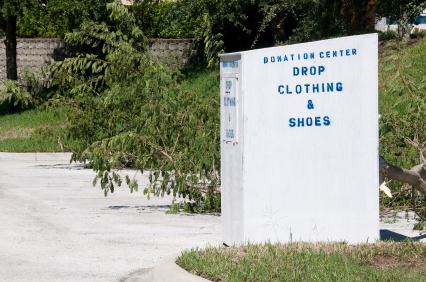Fashion trends come and go, prompting us to weed out closet-hogging has-beens so that we can give the red carpet treatment to their infinitely more stylish replacements. That much-celebrated pre- and post-shopping buzz eventually wears off, but for some, the whole experience is as intoxicating as it is adrenaline boosting. Except for the part where consumer guilt begins setting in — not because of the numbers emblazoned on the price tag, but rather due to the realization that the clothing about to be dethroned has logged in mere weeks of actual “wear time.”
Critics don’t call it fast fashion for nothin’. Like its edible, drive-thru counterpart, “trendy-today-wouldn’t-be-caught-dead-in-it-tomorrow” duds live fast and die young. Consumer desire, fueled by fashion magazines and Hollywood culture, sustains newly launched must-have items up until a point in the comparatively immediate future when they are dropped like a hot, nerdy, what-were they-thinking potato. This endless cycle doesn’t bode well for our landfills, where at least in the U.S., close to 11 million tons of textiles succumb to death by premature burial every year. Despite falling prey to cheap, easy-to-obtain and equally effortless-to-dispose-of garments, most of us — due to simple practicality or clamoring pangs of guilt — do our best to make sure that what we no longer want is at the very least donated to a good cause. Whether we take advantage of citywide textile recycling bins or offer our duds to charitable organizations, we feel relieved and even comforted in the notion that in the immediate future, less fortunate individuals will likely be strutting their stuff in the military-inspired blazer or the zippered ankle jeans that no longer deserve a place in our righteous wardrobe.
If only it were that easy. The fact of the matter is that clothing donations do not immediately reach those with compromised social and financial backgrounds. In fact, there are some instances where they never make it beyond the container they are collected in. It’s helpful to first understand that, upon being dropped into a charity bin, items are graded to determine their actual condition/quality, sorted by fabric type/garment style, and either:
Whether we take advantage of citywide textile recycling bins or offer our duds to charitable organizations, we feel relieved and even comforted in the notion that in the immediate future, less fortunate individuals will likely be strutting their stuff in the military-inspired blazer or the zippered ankle jeans that no longer deserve a place in our righteous wardrobe.
If only it were that easy. The fact of the matter is that clothing donations do not immediately reach those with compromised social and financial backgrounds. In fact, there are some instances where they never make it beyond the container they are collected in. It’s helpful to first understand that, upon being dropped into a charity bin, items are graded to determine their actual condition/quality, sorted by fabric type/garment style, and either:
- Sold at a discounted rate to thrift store patrons
- Sold in bulk to developing nations
- Cut into wiping rags that are ideal for industrial use
- Transformed into household insulation
- Shredded into fibers that can then be recycled into new garments or other fabric-based items
- The endless cycle of hot/cold fashion trends has created a global surplus of used women’s clothing, with seven times more ladies duds available than men’s.
- Despite the fact that various domestic and international shoe donation programs exist (not to mention shoe material recycling options courtesy of Retex and Nike) American citizens still threw away 300+ million pairs of shoes in 2010.
- Of the 16.8 million pounds of discarded duds that Trans-America Trading Company sorts through annually, 35% is exported as clothing, 33% is transformed into fibers before then being reprocessed and 25% is converted into industrial wiping rags.
- Beware of convenient freestanding donation bins — in many cases, companies rather than charities are benefitting from profits by reselling the contents via the textile recycling market.
- When in doubt, tattered 100% cotton items can always be cut up into very small pieces and completely buried in a home compost pile!